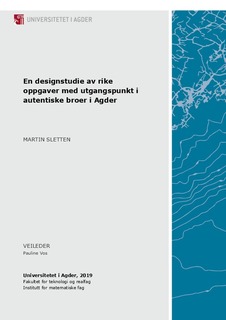| dc.description.abstract | This master’s thesis describes a study about designing mathematical tasks, starting from authentic bridges in the Agder region. The aim of the study was to design classroom tasks, which require pupils to employ all aspects of their mathematical proficiency (explained below). The empirical basis of the study was a classroom-based implementation of the tasks to evaluate what aspects of mathematical proficiency thehigh schoolpupils used when solving the tasks.As a mathematics teacher, I follow the current national curriculum. In 2020, there will come a new national curriculum, which describes new core elements (Utdanningsdirektoratet, 2018b). These correspond with the five strands of mathematical proficiency as described by Kilpatrick, Swafford and Findell (2001),these five strands are conceptual understanding, procedural fluency, strategic competence, adaptive reasoning and productive disposition. This connection makes the study I have conducted, very relevant for future teachers and can be for inspiration and motivation for others with a view to practical use and further research.The theoretical chapter focuses on pupils' mathematical proficiency and which theoriesthat support my study. The five strands of mathematical proficiency as described by Kilpatrick et al. (2001) are the backdrop to this thesis. In this chapter, I define how "mathematical proficiency" consists of five strands that are mutually dependent on each other and how the development of mathematical proficiency depends on the development of each strand.The method in this study is Design Research. This is a young researchmethod, which is not (yet) described in the handbooks on research methods. When necessary, I picked elements from action researchas supplement. In Design Research, we recognize three phases: the preliminary research, the development phase, and the evaluation phase. In the preliminary research, I made an orientation of the literature and I made an inventory of the beautiful bridges in our region. In the development phase, I started from seven bridges and developed tasks, which I tested in three different rounds (with friends, colleagues, etc.), and then re-developed. In the end, I had three mathematical modelling tasks based on authentic bridges, to take into a classroom situation with two high schoolpupils. In this evaluation phase, the main study, the group of students worked together to solve the three mathematical modelling tasks about authentic bridges from the local area. I observed the students and took field notes and sound recordings, which I later analysed. From the transcripts, I analysed the pupils’ activities, and into which strand of mathematical proficiency these fitted. I have produced the analysis in a table,to give a visual overview of the strands of mathematical proficiency beingused in the solution process. The result showthat,for each of the tasks,aspects of all five strands were needed when the group solved the task.My results show that we can design rich tasks, which start from elements inthe local area, and which require students to employ all strands of mathematical proficiency. The design of these tasks is not straightforward but requires several rounds of testing and improving. Students, who work on such tasks, will develop flexible mathematics skills that are useful in everyday life. | nb_NO |

